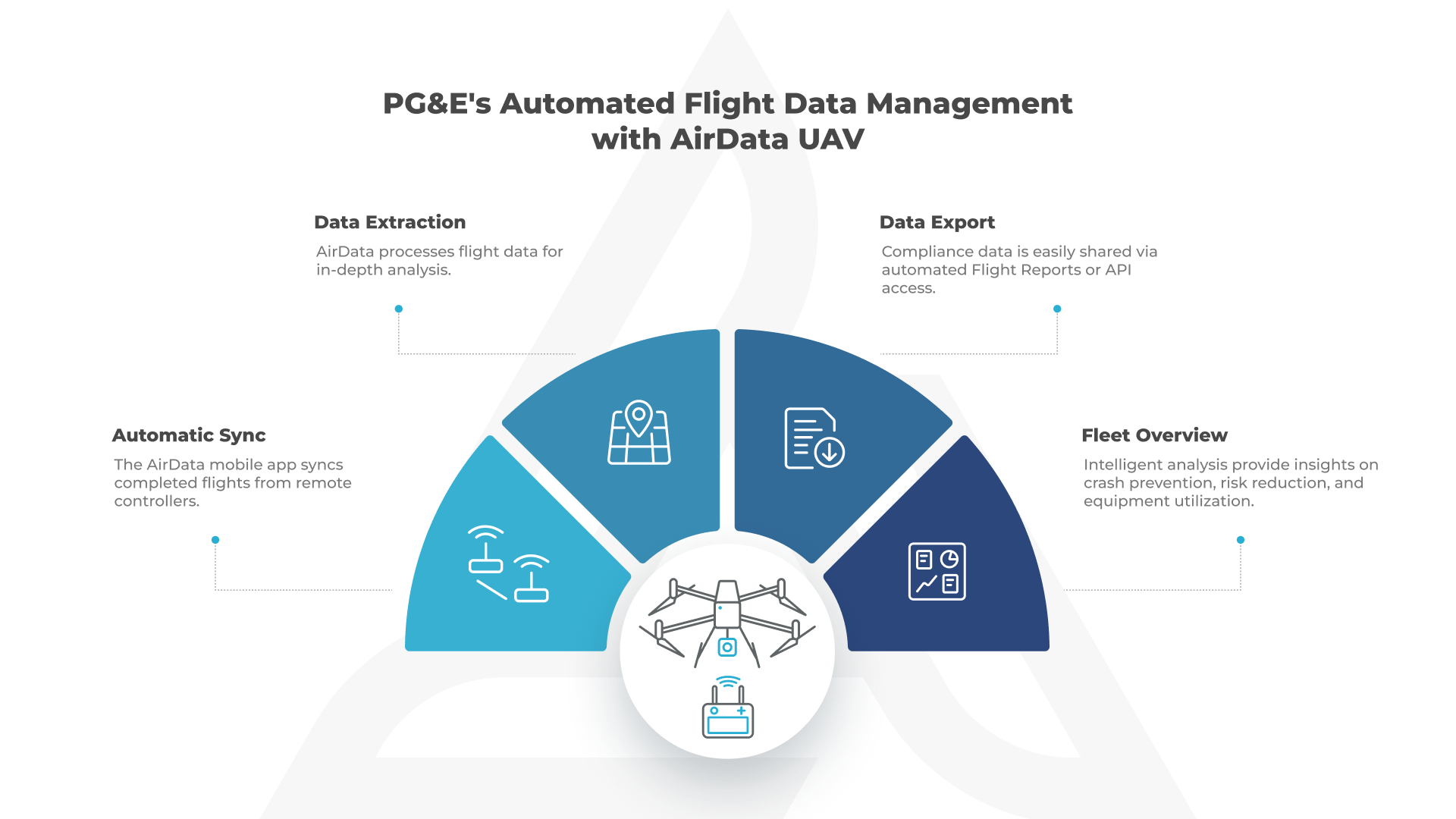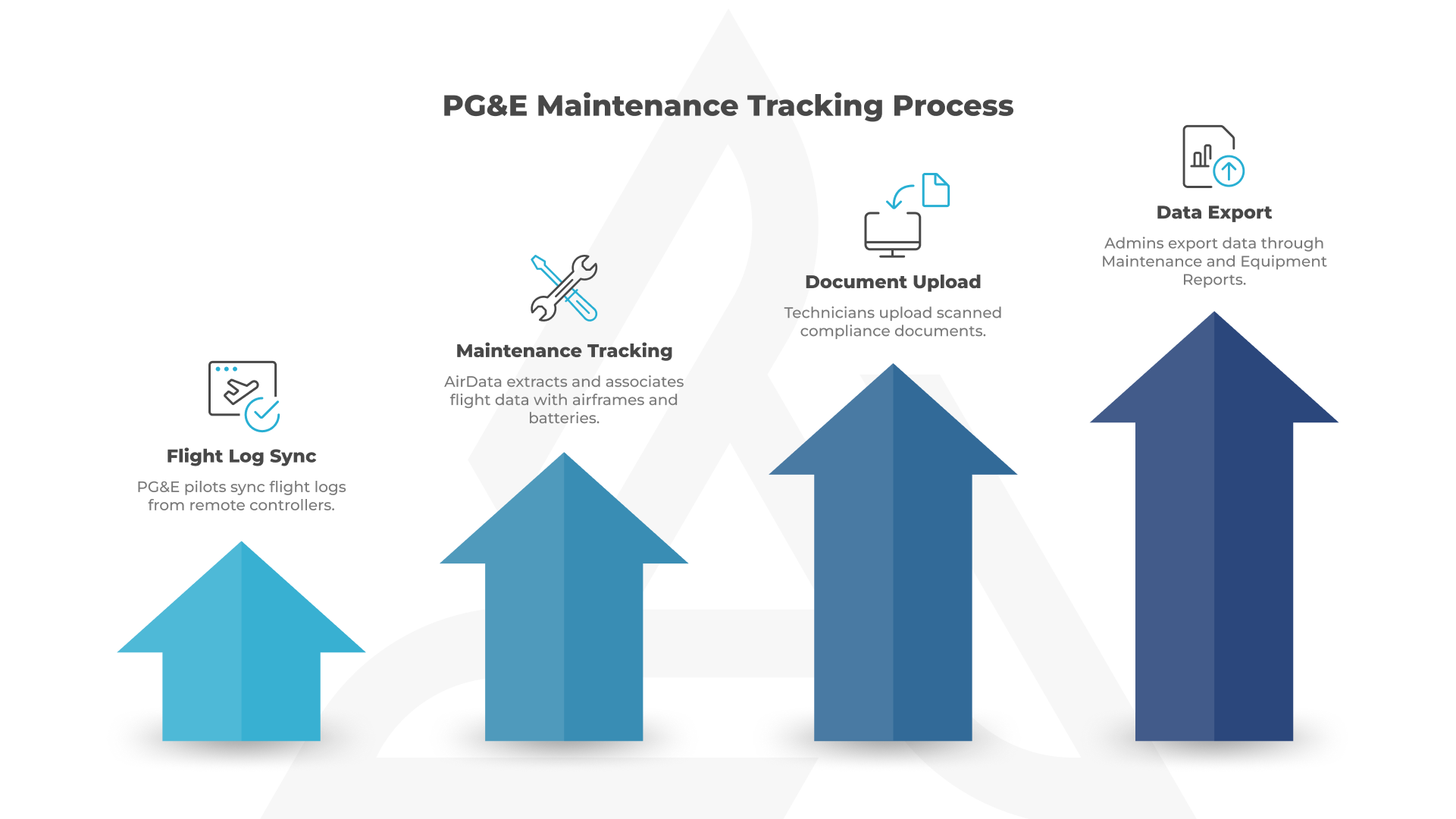Case Study: PG&E Automates BVLOS Compliance with AirData
Summary and Objectives
PG&E’s Drone Program
Pacific Gas and Electric (PG&E) has long been an innovator of drone use in the utilities industry. PG&E provides natural gas and electricity to a 70,000-square-mile service area in Northern and Southern California, and their operations entail a diverse scope of activities. The use of drones has been transformative for PG&E and the utilities sector as a whole, magnifying inspection coverage, reducing aviation costs, and increasing personnel safety.
As PG&E’s drone program has expanded in scope, complexity, and size, they have leveraged AirData’s platform to help automate compliance requirements and allow their operations to scale. In this article, we will discuss PG&E’s methods to automate and unify different regulatory workflows, resulting in simpler and more intuitive procedures for their pilots, technicians, and administrators.
Significance of BVLOS Operations
At the forefront of PG&E’s current efforts are Beyond Visual Line of Sight (BVLOS) drone capabilities. BVLOS drone flights are closely regulated by the Federal Aviation Administration. The FAA has granted just over 400 BVLOS waivers across the United States in the first four years of the Part 107 waiver program, and PG&E is one of the very first utility providers to receive this authorization.
Obtaining a BVLOS waiver was motivated by the spate of wildfires in recent years, as well as the elevated risk of future fires in California. PG&E is tasked with monitoring large sections of at-risk territory in a safe and efficient manner. Because of the FAA’s close monitoring of BVLOS flights, PG&E leverages AirData’s automation capabilities to ensure thorough capture of operations data and increase the ease of reporting. This means that, even with the BVLOS waiver in place, PG&E can prioritize the continuous development of safe and scalable operations.
Kellen Kirk, PG&E’s Manager of UAS and Fixed Wing Operations, said, "Implementing AirData has centralized our flight logging, compliance reporting, and maintenance tracking in an automated and proactive manner. This allows our pilots, technicians, and administrators to focus on their respective missions with confidence that regulations are being followed. The utilities industry is rapidly innovating in drone use, and AirData is a key part of how we stay at the forefront of these changes.”
Obtaining a BVLOS Waiver
PG&E worked with Skyfire Consulting, now Skyfire AI, to obtain their original BVLOS waiver. BVLOS waivers allow them to conduct flights across extensive sections of infrastructure in areas with high threat of fire. Skyfire AI works with organizations seeking FAA COAs and Part 107 waivers.
From the very beginning, PG&E has been at the leading edge of what’s possible with uncrewed systems,” said Skyfire AI Co-Founder, Matt Sloane. “Since that time, they have been a shining example of how to implement advanced drone operations safely, and the need for more comprehensive drone regulations. We found that AirData’s automation features really helped streamlined operations on the ground, while also providing powerful tools to create mature, thorough compliance processes.”
Challenges and Solutions
BVLOS Waiver Requirements
BVLOS waiver requirements touch on virtually every step of drone flight. They include governance for aircraft activity logs, flight personnel records, and equipment service histories. Operators and fleet managers must comply with these requirements and be able to present records of adherence to FAA Administrators.
The most critical workflows for the PG&E team center around the automated capture of aircraft activity, the tracking of flight participants such as pilots and visual observers, and detailed accounts of maintenance events. This case study explores how the PG&E drone program leverages AirData’s platform to help automate various compliance workflows to create simple, comprehensive, and intuitive procedures for their drone operators and fleet administrators.
1) Key Requirement: Detailed Flight Activity and Participant Logs
The FAA waiver requires that PG&E pilots have access to key telemetry data during each BVLOS flight performed. PG&E’s internal procedures also require that these data fields be logged in their flight records. This telemetry data includes, and is not limited to, the following fields: “sUA [small Unmanned Aircraft] altitude, sUA position, sUA direction of flight, and sUAS flight mode….”
Additionally, location must be tracked to show that flights are occurring within authorized areas.
The BVLOS waiver also regulates the “direct participants” of flights such as: “the remote PICs, persons manipulating the controls, VOs, and any persons whose involvement is necessary for safety of the sUA operation.”
Joshua Hill, UAS Operations Supervisor at PG&E, said, "We are always looking to advance our use of drone technology. Our teams utilize them to access hazardous and remote locations while providing unprecedented response times. AirData’s ability to track aircraft locations, complete checklists, and schedule missions keeps us aligned and responsive. It’s incredibly easy to use, highly reliable, and backed by a responsive support team. Automating syncing helps us eliminate manual entry errors, and the intuitive interface makes it easy to access critical flight data.”
Solution: AirData’s Automated Flight Syncing and Analysis

AirData UAV supports the automated syncing of flight logs directly from the remote controllers, flight apps, or cloud servers of most major commercial drone providers. As a brand-agnostic platform, AirData leads the industry in support for flight uploads from different drone manufacturers.
PG&E has configured the AirData platform to auto-sync flights from their enterprise Skydio and DJI aircraft. Once a flight log is uploaded, the AirData platform displays key data for record-keeping, analysis, and reporting. Data fields include flight paths, flight participants, wind conditions, and flight advisories at the time of operation. Customizable checklists can be automatically synced to augment data with risk scores, safety checks, and incident reports.
PG&E uses a combination of AirData’s Standard Flight Report and Enterprise API to export flight data in a more automated manner.
2) Key Requirement: Maintenance Service and Flight Test Records
PG&E’s BVLOS waiver requires that detailed records of aircraft use and maintenance must be maintained. This includes procedures for a “functional flight test” that must occur following each maintenance service.
The waiver also stipulates that PG&E is required to “maintain each sUAS and its components in accordance with manufacturer's instructions and recommendations.” Records of any service type, such as “repair, inspection, modification, replacement, and system software upgrades” must be kept for each aircraft and its components.
Signed documentation is required to certify the date and description of the work, as well as the name of the technician. Functional flight tests must also be logged, with records showing “calendar date, sUA registration number, remote PIC who performed the functional test flight, duration of the flight, and the result of the functional flight test.”
The equipment management features in AirData have been instrumental in helping us streamline and consolidate maintenance procedures,” said Ammar Nazir, PG&E’s Expert Aircraft Maintenance Coordinator. “Automated tracking and alerting allow us to stay proactive with our maintenance efforts, while the document upload and data analysis features help ensure our work is closely documented and compliant. We are constantly updating our workflows, and AirData has allowed us to scale and evolve by providing seamless data flow between our pilots and the rest of the organization."
Solution: AirData’s Maintenance Tracking, Alerting, and Document Upload

PG&E makes use of AirData’s Maintenance, Alerting, and Equipment Management systems to track the different pieces of service data required by the FAA BVLOS waiver. The AirData platform uses the flight logs uploaded by PG&E pilots to automatically create aircraft profiles. This allows PG&E to easily maintain an up-to-date list of active aircraft, while being able to quickly access each aircraft’s flight history.
To comply with manufacturer-recommended servicing, PG&E uses AirData’s Customized Maintenance feature to create service schedules mapped to DJI’s maintenance descriptions and service intervals. Data from each flight log is automatically attributed to each aircraft, providing a seamless way to track flight counts and flight hours. The PG&E team then uses these values in AirData’s Alerts dashboard to set reminders for upcoming maintenance.
Documents for maintenance and functional flight tests are uploaded to each service event in AirData. In the case an FAA administrator requires evidence of a maintenance service, uploaded records can easily be downloaded from the AirData web portal.
For the regular export of maintenance data, the PG&E team uses AirData’s customizable Equipment and Maintenance Reports. These reports can be used to quickly export usage statistics, aircraft readiness info, and completed service items.
Results
Integrating AirData UAV into their compliance procedures has allowed PG&E to unify a large number of compliance needs in one software platform. Previously, their teams relied on a variety of separate tools to thoroughly capture data. This constrained growth and development, requiring training for unrelated toolsets, as well as burdensome manual data entry. As drones advance in capability, innovators like PG&E will continue to evolve their use cases. Safety and compliance become increasingly important as their scope of operations becomes both larger and more sophisticated.
Remote BVLOS flights are a game changer for our operations, and my priority is to make sure we innovate responsibly and safely,” said Jon Teach, PG&E’s Expert Program Manager of UAS Special Projects. “One of the largest challenges we face with this new type of operations is the maintenance requirements set forth in our waivers. Thanks to AirData’s ability to track maintenance it assures that our aircraft remain compliant with our waivers and internal procedures.”
The use of AirData has allowed their drone program to benefit from automation at multiple levels. Pilots are able to focus on flying, knowing their flight records will automatically sync to the AirData platform. Team leaders can make proactive decisions using the intelligent tracking available in the Maintenance and Alerting dashboards. This communication then empowers key decision makers as they strategically guide the evolution of the program as a whole.
PG&E’s administrators are continuously working to meet the challenges of emerging technologies and regulation. AirData allows their teams to collect a greater scope of data than what is currently required by the FAA. This provides PG&E with future-proofing against regulation changes, and sets a strong precedent for thoroughness in safety. The foundational systems they set in place apply to not only their BVLOS flights, but all of their drone operations. As the landscape of drone use becomes more sophisticated and specialized, PG&E’s use of automated fleet management, in-depth data analysis, and intelligent compliance toolsets finds them poised for growth and innovation.
Learn More
PG&E Drone Use and BVLOS
PG&E Gets BVLOS Waiver for Entire State of California
Skyfire helps nation’s largest utility company PG&E obtain BVLOS waiver for use across California
Navigating Innovation: PG&E Hosts Utility Drone Operations Conference
PG&E is getting closer to remote, autonomous line inspections
How PG&E is using remote drones in California operations
PG&E Leads the Way: Drones Transforming Utility Operations
FAA Regulations
Visual line of sight aircraft operation
AirData Features and Ecosystem
AirData’s Automated Flight Upload Capabilities
AirData Webinar on Pilot Management
AirData Webinar on Aircraft Maintenance Tracking
AirData Webinar on Customized Checklists